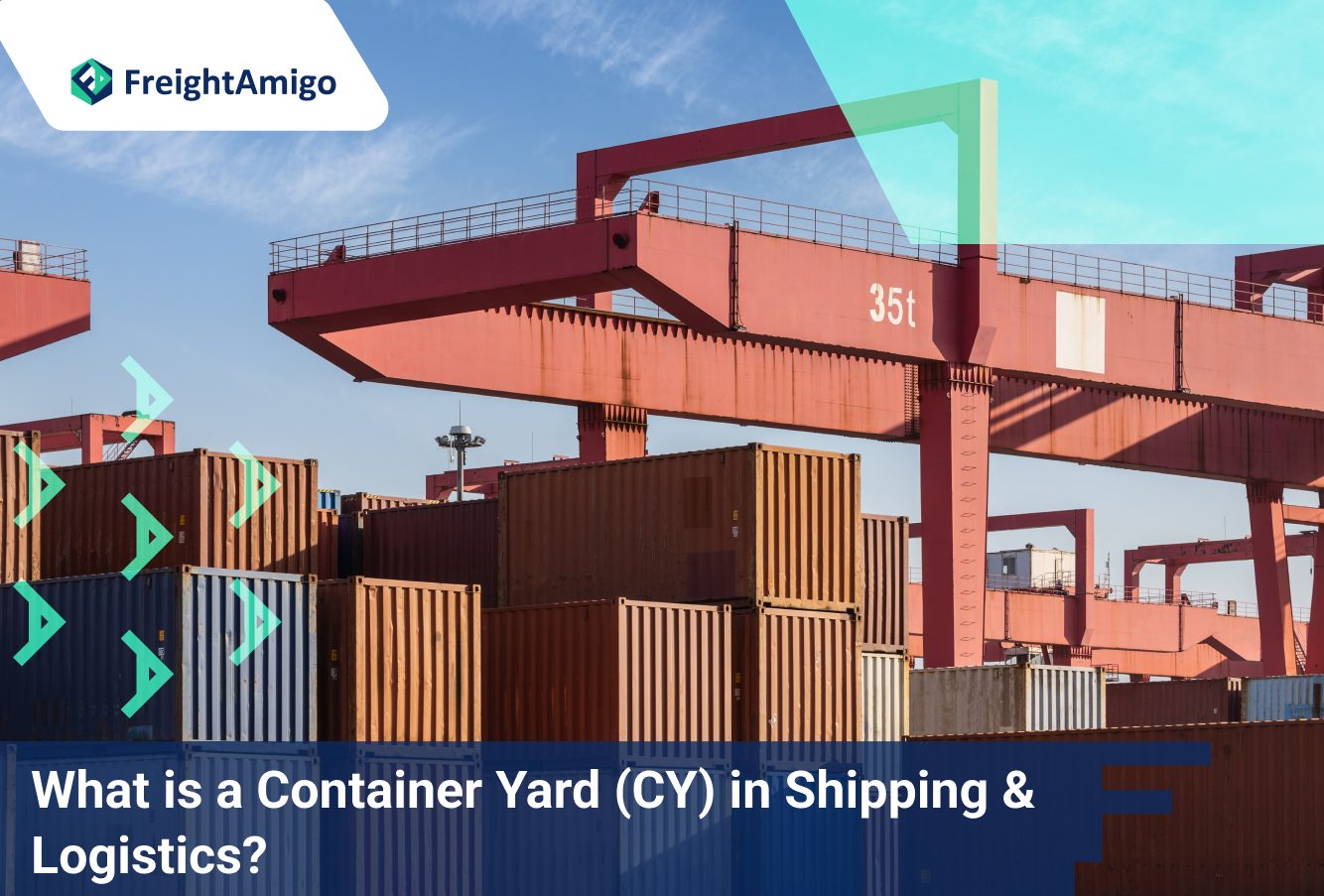What is a Container Yard (CY) in Shipping & Logistics?
Latest update on 26 March, 2024 by Caspian Ng– Marketing Analyst at FreightAmigo
In the shipping and logistics industry, containerization plays a crucial role in the transportation of goods and materials. Shipping lines invest significantly in purchasing and maintaining containers, which are essential for their operations. To efficiently manage the logistical challenges of container storage, shipping companies establish Container Yard (CY). These yards serve as centralized locations for storing, maintaining, and repairing shipping containers, ensuring the smooth flow of cargo in the global supply chain. Take advantage of containerization and optimize your logistics operations with FreightAmigo.
Want to compare the best Express, Air Freight, Sea Freight, Rail Freight & Trucking rates so as to have better control on cost?
Definition of a Container Yard (CY)
A container yard, also known as a CY, is a vast space used to accommodate containers before they are packed with consignments and shipped to the port. The primary purpose of a container yard is to provide a separate space for container storage and maintenance, minimizing the utilization of valuable space at the port. Container yards are equipped with cranes and other handling equipment to facilitate the movement, stacking, and organizing of containers.
Importance of Container Yards
Container yards play a crucial role in the shipping and logistics industry for several reasons. Firstly, they allow shipping lines to efficiently manage their inventory of containers, ensuring a steady supply for their operations. Secondly, container yards provide a secure location for storing containers, reducing the risk of theft, tampering, and damage. Additionally, container yards enable the optimization of space, allowing for the stacking of containers to maximize storage capacity. By separating the container storage from the port, container yards contribute to the smooth flow of cargo and reduce congestion at the port.
Container Yard Operations
Container yards involve various operations to ensure the efficient management of containers. These operations include crane operations, space management, and maintenance and repairs.
Crane Operations
One of the critical operations in a container yard is crane operations. Yard cranes are used to move containers within the storage facility. These cranes are expensive assets for shipping companies and should be utilized optimally. Companies perform several yard crane management activities, such as monitoring vessel schedules and allocating cranes to different blocks. The goal is to minimize crane movement between blocks, ensuring efficient container handling.
Space Management
Space management is another important aspect of container yard operations. Limited physical storage space is a constraint faced by container yard operators. To maximize space utilization, containers are stacked on top of each other using cranes. However, careful consideration is given to the positioning of containers to facilitate easy retrieval. Containers requiring maintenance are stored separately from those ready for use. Effective space management techniques ensure efficient container organization and retrieval.
Maintenance and Repairs
Container yards also handle maintenance and repairs of containers. Containers that require repairs or maintenance are directed to specific areas within the yard. Yard workers, equipped with the necessary tools and equipment, perform inspections, repairs, and cleaning activities. This ensures that containers are in good condition and comply with international shipping standards and regulations.
Container Yard Location
Container yards are strategically located near ports or inland (dry) ports. This proximity allows for the efficient transfer of containers between the yard and the port. By situating the container yard close to the port, shipping lines can streamline their operations and minimize transit time. Additionally, container yards located near inland ports facilitate the transportation of goods to and from the port, ensuring smooth intermodal connectivity.
Container Yard vs. Container Freight Station (CFS)
Although container yards and container freight stations (CFS) are both facilities used in the shipping industry, they serve different purposes. A container yard is primarily used for the temporary storage and handling of containers. It provides a secure location for containers before they are loaded onto a shipping vessel or after they have been unloaded.
On the other hand, a container freight station (CFS) is a facility where containers are received and processed before being shipped to their final destination. A CFS includes areas for stuffing and stripping containers and provides storage facilities for containers awaiting loading onto a vessel. The primary purpose of a CFS is to ensure proper handling and packing of containers before they are shipped.
Benefits of Container Yards
Container yards offer several benefits to shipping lines and the overall supply chain.
Efficient Use of Space
Container yards maximize the use of available space by stacking containers vertically. The standardized dimensions of containers allow for safe and secure stacking. By efficiently utilizing space, container yards can store a larger number of containers within a smaller area. This is especially valuable in urban areas where land is scarce and expensive.
Flexibility
Container yards provide flexibility in logistics operations. In addition to storage, container yards offer value-added services such as repairs, maintenance, and cleaning. This versatility allows shipping companies to adapt to changing market demands and efficiently handle various logistics challenges.
Security
Container yards prioritize security to protect containers and cargo. Perimeter fencing and controlled access points prevent unauthorized entry. Surveillance systems, including cameras and motion detectors, help detect and deter potential security breaches. Regular inspections, tracking systems, and collaboration with law enforcement further enhance container security.
Easy Transportation
Container yards are strategically located to facilitate easy transportation of containers. Proximity to ports, highways, rail lines, and intermodal connectivity ensures efficient movement of containers to their final destinations. This reduces the time and effort required for loading and unloading cargo, enhancing overall transportation efficiency.
Cost Effectiveness
Container yards offer cost-effective storage options. Efficient space utilization, improved operational processes, centralized storage, intermodal connectivity, and value-added services contribute to cost reduction for logistics companies and shippers. Container yards provide a cost-effective solution for managing containers and optimizing supply chain operations.
Conclusion
Container yards are essential components of the shipping and logistics industry, providing secure storage, efficient container management, and improved transportation capabilities. These yards play a crucial role in ensuring the smooth flow of cargo in the global supply chain. With their efficient use of space, flexibility, security measures, and cost-effectiveness, container yards contribute to the growth and success of shipping companies and the overall logistics industry.
By employing advanced technologies and innovative strategies, container yards continue to enhance the customer experience and support the global expansion of trade. As shipping lines invest in container yards, they demonstrate their commitment to providing efficient and reliable services to their customers. The establishment and proper management of container yards highlight the industry’s dedication to continuous improvement and the optimization of the supply chain. FreightAmigo provides comprehensive solutions for container management, including container tracking, storage optimization, and efficient transportation planning, ensuring the smooth movement of containers and enabling seamless global trade.
Visit FreightAmigo page and transform your shipping and logistics processes for success in the global market.
Read More:
The Importance of Jewelry Shipping Insurance: Protecting Your Precious Gems and Valuables
【Crane Shipping 】 Oversized Shipment from Italy in 1 Month
The Advantages of Shared Truckload Shipping: Cost Savings and Efficiency
If you have any inquiries on logistics/supply chain, feel free to contact FreightAmigo now:
Chat with us online | Hotline: +852 28121686 | WhatsApp: +852 27467829









































